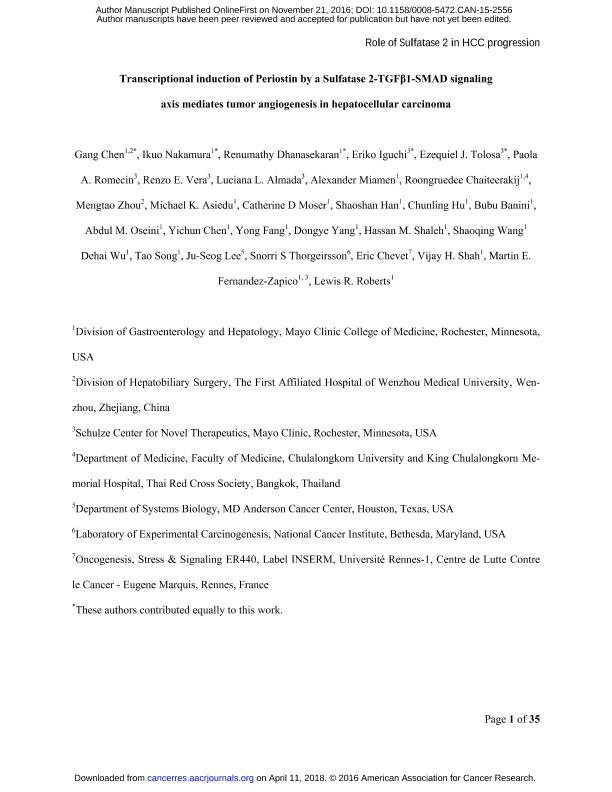Artículo
Transcriptional Induction of Periostin by a Sulfatase 2-TGFb1-SMAD Signaling Axis Mediates Tumor Angiogenesis in Hepatocellular Carcinoma
Chen, Gang; Nakamura, Ikuo; Dhanasekaran, Renumathy; Iguchi, Eriko; Tolosa, Ezequiel Julian ; Romecin, Paola A.; Vera, Renzo Emanuel
; Romecin, Paola A.; Vera, Renzo Emanuel ; Almada, Luciana Victoria; Miamen, Alexander G.; Chaiteerakij, Roongruedee; Zhou, Mengtao; Asiedu, Michael K.; Moser, Catherine D.; Han, Shaoshan; Hu, Chunling; Banini, Bubu A.; Oseini, Abdul M.; Chen, Yichun; Fang, Yong; Yang, Dongye; Shaleh, Hassan M.; Wang, Shaoqing; Wu, Dehai; Song, Tao; Lee, Ju-Seog; Thorgeirsson, Snorri S.; Chevet, Eric; Shah, Vijay H.; Fernandez-Zapico, Martin E.; Roberts, Lewis R.
; Almada, Luciana Victoria; Miamen, Alexander G.; Chaiteerakij, Roongruedee; Zhou, Mengtao; Asiedu, Michael K.; Moser, Catherine D.; Han, Shaoshan; Hu, Chunling; Banini, Bubu A.; Oseini, Abdul M.; Chen, Yichun; Fang, Yong; Yang, Dongye; Shaleh, Hassan M.; Wang, Shaoqing; Wu, Dehai; Song, Tao; Lee, Ju-Seog; Thorgeirsson, Snorri S.; Chevet, Eric; Shah, Vijay H.; Fernandez-Zapico, Martin E.; Roberts, Lewis R.
 ; Romecin, Paola A.; Vera, Renzo Emanuel
; Romecin, Paola A.; Vera, Renzo Emanuel ; Almada, Luciana Victoria; Miamen, Alexander G.; Chaiteerakij, Roongruedee; Zhou, Mengtao; Asiedu, Michael K.; Moser, Catherine D.; Han, Shaoshan; Hu, Chunling; Banini, Bubu A.; Oseini, Abdul M.; Chen, Yichun; Fang, Yong; Yang, Dongye; Shaleh, Hassan M.; Wang, Shaoqing; Wu, Dehai; Song, Tao; Lee, Ju-Seog; Thorgeirsson, Snorri S.; Chevet, Eric; Shah, Vijay H.; Fernandez-Zapico, Martin E.; Roberts, Lewis R.
; Almada, Luciana Victoria; Miamen, Alexander G.; Chaiteerakij, Roongruedee; Zhou, Mengtao; Asiedu, Michael K.; Moser, Catherine D.; Han, Shaoshan; Hu, Chunling; Banini, Bubu A.; Oseini, Abdul M.; Chen, Yichun; Fang, Yong; Yang, Dongye; Shaleh, Hassan M.; Wang, Shaoqing; Wu, Dehai; Song, Tao; Lee, Ju-Seog; Thorgeirsson, Snorri S.; Chevet, Eric; Shah, Vijay H.; Fernandez-Zapico, Martin E.; Roberts, Lewis R.
Fecha de publicación:
02/2017
Editorial:
American Association for Cancer Research
Revista:
Cancer Research
ISSN:
0008-5472
e-ISSN:
1538-7445
Idioma:
Inglés
Tipo de recurso:
Artículo publicado
Clasificación temática:
Resumen
Existing antiangiogenic approaches to treat metastatic hepatocellular carcinoma (HCC) are weakly effectual, prompting further study of tumor angiogenesis in this disease setting. Here, we report a novel role for sulfatase 2 (SULF2) in driving HCC angiogenesis. Sulf2-deficient mice (Sulf2 KO) exhibited resistance to diethylnitrosamine-induced HCC and did not develop metastases like wild-type mice (Sulf2 WT). The smaller and less numerous tumors formed in Sulf2 KO mice exhibited a markedly lower microvascular density. In human HCC cells, SULF2 overexpression increased endothelial proliferation, adhesion, chemotaxis, and tube formation in a paracrine fashion. Mechanistic analyses identified the extracellular matrix protein periostin (POSTN), a ligand of avb3/5 integrins, as an effector protein in SULF2-induced angiogenesis. POSTN silencing in HCC cells attenuated SULF2-induced angiogenesis and tumor growth in vivo. The TGFb1/SMAD pathway was identified as a critical signaling axis between SULF2 and upregulation of POSTN transcription. In clinical HCC specimens, elevated levels of SULF2 correlated with increased microvascular density, POSTN levels, and relatively poorer patient survival. Together, our findings define an important axis controlling angiogenesis in HCC and a mechanistic foundation for rational drug development.
Palabras clave:
Angiogenesis
,
Hepatocellular Carcinoma
,
Sulfatase 2
Archivos asociados
Licencia
Identificadores
Colecciones
Articulos(CCT - CORDOBA)
Articulos de CTRO.CIENTIFICO TECNOL.CONICET - CORDOBA
Articulos de CTRO.CIENTIFICO TECNOL.CONICET - CORDOBA
Citación
Chen, Gang; Nakamura, Ikuo; Dhanasekaran, Renumathy; Iguchi, Eriko; Tolosa, Ezequiel Julian; et al.; Transcriptional Induction of Periostin by a Sulfatase 2-TGFb1-SMAD Signaling Axis Mediates Tumor Angiogenesis in Hepatocellular Carcinoma; American Association for Cancer Research; Cancer Research; 77; 3; 2-2017; 632-645
Compartir
Altmétricas



